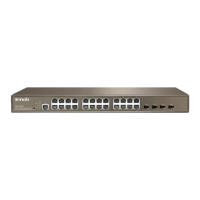Select to enable/disable the STP feature or make
no change. By default, the STP feature is
disabled. To activate the STP feature, you must
enable STP both globally on the entire device
and specifically on desired port(s).
An edge port is a port that is connected to the
terminal directly. Ports that are designated as
edge ports transit rapidly from the blocked state
to the forwarding state without delay. An edge
port loses its status if it receives a BPDU packet,
immediately becoming a normal spanning tree
port. By default, all ports are edge ports.
A P2P port is also capable of rapid transition.
Under RSTP/MSTP, all ports operating in
full-duplex mode are considered to be P2P ports.
By default, port establishes a link automatically.
Configure port parameters under different
instances.
By default, the port priority is set to 128.
Enable/disable port default path cost. You can
specify a custom port path cost between 1 and
200,000,000 if you disable the default port path
cost. When enabled, port path cost can be
configured automatically and 802.1at is
supported.
The default path cost is 200,000,000. Only if you
disable the default path cost option, can path
cost be configurable.
To config STP settings on a batch of ports concurrently, click Config as seen below:

